|
|
Scientific and Theoretical Problems and Countermeasures for the High Quality Development of “Four Foundations” in China
ZHANG Li, ZHANG Qingjie
2021 Vol. 36 (8): 785–788
 Abstract
Abstract(
648 )
 HTML
HTML(
20)
 PDF
PDF(487KB)(
688
)
Basic materials, basic components, basic software and basic algorithms (abbreviated as “Four Foundations”) are the cornerstone of the development of China’s basic industry and high-tech industry. The next 15 years will be a critical period for China’s “Four Foundations” to achieve breakthrough against the siege, self-reliance, high-quality development and lead the world. Through strategic research, this paper analyzes the current situation of the development of “Four Foundations” in China, puts forward the core scientific theoretical problems faced by the development of “Four Foundations”, and suggests that the system construction from five aspects is conducive to breaking through the encirclement and surpassing the original innovation environment and system mechanism.
|
|
|
Rare Earth Doped Gd2O2S Scintillation Ceramics
LI Jiang, DING Jiyang, HUANG Xinyou
2021 Vol. 36 (8): 789–806
 Abstract
Abstract(
1046 )
 HTML
HTML(
43)
 PDF
PDF(6782KB)(
2543
)
Rare earth ions doped Gd2O2S scintillators are new type of oxysulfide scintillators, which have been developed since 1980s. The Gd2O2S matrix with cross section of high density and high thermal neutron absorption has high X ray and thermal neutron stopping capacity. The doping of different rare earth ions (Pr3+, Tb3+, etc.) shows fast decay or high light yield, which plays a very important role in application of scintillation. Composition control of oxysulfide is always a key problem to be solved in the synthesis process. However, the high melting point of Gd2O2S material and the serious volatilization of sulfur restrict the preparation of Gd2O2S single crystals, with high optical quality and excellent scintillation performance. Ceramic is the main application form of Gd2O2S scintillation material. Its pure phase Gd 2O2S phosphors with small particle size, narrow particle size distribution and low agglomeration is the key to sintering high quality scintillation ceramics. These ceramics prepared by simply increasing the sintering temperature produce a large number of sulfur vacancies and oxygen vacancies, decreasing the scintillation properties. Therefore, preparation of Gd2O2S scintillation ceramics usually need pressure assistance to increase the production cost. In this paper, their scintillation mechanism and research situation are introduced firstly. Then, their fabrication process, solution of defects removal, research status and applications in neutron imaging and medical X-CT fields are overviewed. Finally, we summarized the previous and prospected the future development of Gd2O2S scintillation ceramics.
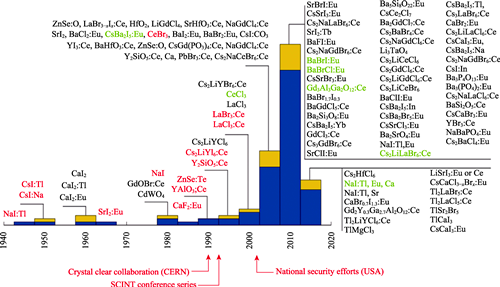
|
|
|
Phosphor Ceramics for High-power Solid-state Lighting
PENG Xinglin, LI Shuxing, LIU Zehua, YAO Xiumin, XIE Rongjun, HUANG Zhengren, LIU Xuejian
2021 Vol. 36 (8): 807–819
 Abstract
Abstract(
1074 )
 HTML
HTML(
49)
 PDF
PDF(5580KB)(
1337
)
Due to high power, high brightness, small size, energy saving, and environment friendliness, solid-state lighting has been becoming the most promising lighting technology in this century. As the key material of solid-state lighting, the luminescent properties of phosphors directly determine the crucial parameters such as the color rendering index, luminous efficacy and reliability of solid-state lighting devices. Compared with single crystals, phosphor glasses, phosphor films and quantum-well LEDs, phosphor ceramics have become the most excellent phosphor materials for high-power solid-state lighting due to its excellent thermal and optical properties and easy control of microstructure. In the future, phosphor ceramics is expected to be more widely used and developed in automotive headlights, outdoor lighting, laser TVs, laser cinema projectors, and other fields, and have a broad market prospect. In this review, design principles of high-power solid-state lighting phosphor ceramics are put forward firstly, and then their research progress of oxide phosphor ceramics (mainly refers to Y3Al5O12) and nitrogen/oxynitride phosphor ceramics are reviewed mainly. Finally, the development of phosphor ceramics for high-power solid-state lighting is prospected.
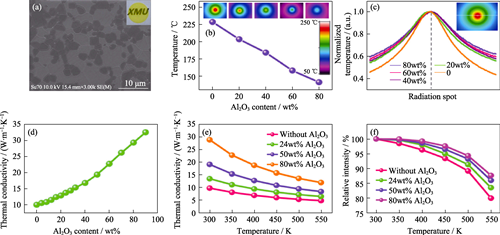
|
|
|
Research Progress of Carbon-supported Metal Single Atom Catalysts for Oxygen Reduction Reaction
HAO Ce, LIU Ziruo, LIU Wei, SHI Yantao
2021 Vol. 36 (8): 820–834
 Abstract
Abstract(
1234 )
 HTML
HTML(
67)
 PDF
PDF(18274KB)(
1840
)
Fuel cells are highly efficient and green devices for direct chemical-to-electrical energy conversion. However, limited by slow kinetics of oxygen reduction reaction (ORR) in cathode, fuel cells require catalysts with noble metal like Pt, thus significantly increasing the cost of the fuel cells. Carbon-supported metal single atom catalysts (C-SACs) have excellent properties such as high atom utilization efficiency and selectivity. In addition, C-SACs show high ORR activity under different pH conditions, hence have been recognized as economical candidates to replace noble metal in fuel cells. This article reviewed the strategies used to improve ORR activity of C-SACs, including selecting different kinds of metal single atoms, tailoring coordination structure of metal centers, and heteroatomic doping to substrate. Performances of C-SACs in rotating disk electrode or battery device are also introduced. At last, the feasibility and potential challenges of C-SACs in practical application are prospected and summarized.
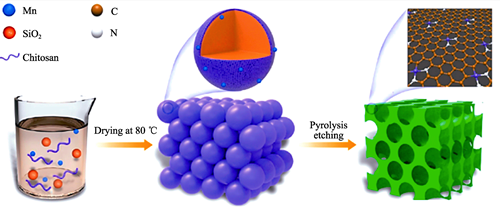
|
|
|
Effect of Mg Content on Thermoelectric Property of Mg3(1+z)Sb2 Compounds
LU Xu, HOU Jichong, ZHANG Qiang, FAN Jianfeng, CHEN Shaoping, WANG Xiaomin
2021 Vol. 36 (8): 835–840
 Abstract
Abstract(
561 )
 HTML
HTML(
19)
 PDF
PDF(1162KB)(
995
)
Mg3Sb2 compound has attracted much attention due to the promising thermoelectric properties and cost advantage. However, it is quite difficult to control Mg content during synthesizing processes because of high saturation vapor pressure and chemical reactivity of Mg element. Herein, Mg3(1+z)Sb2 (z=0, 0.02, 0.04, 0.06 and 0.08) samples were prepared by combination of solid state reaction, ball milling and spark plasma sintering (SPS). Their effects of Mg content on thermoelectric properties of Mg3Sb2 compounds were investigated in this study. Results indicate that actual Mg content rises with nominal Mg content increasing, and their point defect type changes from Mg vacancy(${{\text{{V}''}}_{\text{Mg}}}$) to interstitial Mg($\text{Mg}_{\text{i}}^{\centerdot \centerdot }$), leading to transition of transport behavior from p type (hole carriers predominated) for Mg3(1+z)Sb2 (z=0, 0.02, 0.04) samples to n type (electron carriers predominated) for Mg3(1+z)Sb2 (z=0.06, 0.08) samples. Besides, Mg3(1+0.04)Sb2 sample shows the highest ZT value from room temperature to 770 K, and achieves maximum ZT of 0.28 at 800 K. Additionally, Mg3(1+0.04)Sb2 sample exhibits intrinsic p-type transport behavior for Mg3Sb2 compound, which could serve as matrix to be extrinsically doped in the future study for further improvements of electrical properties and ZT value.
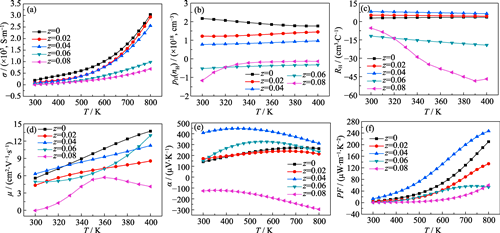
|
|
|
Adsorption of Phosphonate Antiscalant HEDP from Reverse Osmosis Concentrates by La/FeOOH@PAC
LI Chuang, YANG Qingfeng, LU Shengsen, LIU Yangqiao
2021 Vol. 36 (8): 841–846
 Abstract
Abstract(
793 )
 HTML
HTML(
21)
 PDF
PDF(1285KB)(
795
)
Phosphonate antiscalants are commonly used in reverse osmosis (RO) membrane desalination to prevent fouling by mineral scale. However, due to its adverse effects on the ecosystem and the removal of hardness from RO concentrates, it is necessary to remove phosphonate antiscalants before RO concentrates disposal. In this work, using powder activated carbon (PAC) as carrier, La/FeOOH@PAC composite material was prepared via co-precipitation of lanthanum hydroxide and iron oxyhydroxide. The synergistic effect of La/Fe enhanced the adsorption capability of the composite material. Morphology and structure of the adsorbents were characterized by different methods. Adsorption behavior and properties of this composites for phosphonate antiscalant 1-hydroxyethylidene-1,1-diphosphonic acid (HEDP) in simulated reverse osmosis concentrates were also investigated. The effect of molar ratio of La to Fe, adsorption time, initial concentration of HEDP and temperature on the adsorption performance were investigated in details. The results showed that La/FeOOH@PAC composites was successfully synthesized by co-precipitation method. Under the adsorption conditions of 298 K, pH=8.0 and dosage of 0.4 g·L-1, the adsorption isothermal was in accordance with the Langmuir model, and the theoretical maximum adsorption capacity was 65.359 mg·g-1. Its adsorption kinetics could be fitted well with the pseudo-second-order kinetics equation, and adsorption behavior was an exothermic and spontaneous process. XPS analysis showed that the main adsorption mechanism of the adsorbent was the ligand exchange between hydroxyl groups linked with La/Fe and HEDP.
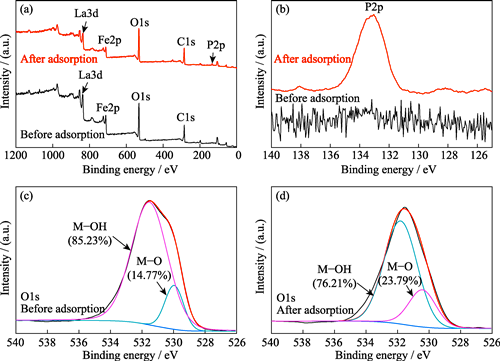
|
|
|
Effect and Mechanism of the Surface Treatment and Gradation Filling of AlN on the Performance of Insulation Layer of Copper Clad Laminate
ZHANG Weiwei, LU Chen, YING Guobing, ZHANG Jianfeng, JIANG Wan
2021 Vol. 36 (8): 847–855
 Abstract
Abstract(
651 )
 HTML
HTML(
27)
 PDF
PDF(4963KB)(
882
)
Introducing thermally conductive ceramic fillers to the copper clad laminate (CCL) resin matrix is an effective way to improve its thermal conductivity. AlN is a kind of ceramic filler with high thermal conductivity and good insulation, but its easy hydrolysis has limited its practical application. In addition, compared with the ceramic filler-resin matrix composite system, systematic research on the properties of the filler filled CCL is relatively rare. In this study, AlN was treated with phosphoric acid to obtain pAlN with excellent hydrolysis resistance. Then, the effects of different pAlN particle sizes and filling amount on the thermal conductivity, peeling strength, dielectric properties and other properties of AlN-filled CCLs were investigated. Finally, the pAlN gradation filling strategy of different particle sizes was adopted to explore the influence of different gradation schemes on the performance of the CCLs, of which the CCL with the best gradation and excellent comprehensive performance was obtained. The results show that the thermal conductivity of CCL insulating layer increases to 0.757 W/(m·K), 160% higher than that of pure resin CCL under the optimal gradation of pAlN-50 μm60%-5 μm5%. It displays excellent mechanical properties ( peel strength of 1.012 N/mm and bending strength of 335 MPa), dielectric properties (dielectric constant of 4.499 and dielectric loss of 6.668×10-3), and the water absorption which is as low as 0.53%. All these data could be a promising guidence for CCL application.
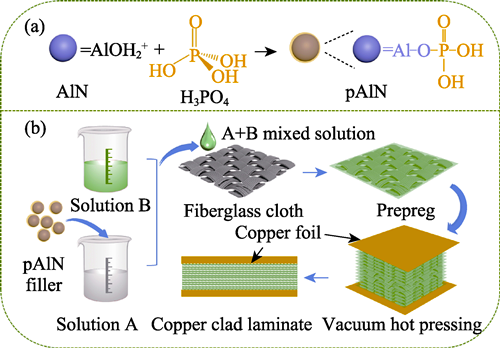
|
|
|
Efficient Adsorption of Radioactive Iodide by Copper/Palygorskite Composite
YU Xiangkun, LIU Kun, LI Zhipeng, ZHAO Yulu, SHEN Jinyou, MAO Ping, SUN Aiwu, JIANG Jinlong
2021 Vol. 36 (8): 856–864
 Abstract
Abstract(
451 )
 HTML
HTML(
13)
 PDF
PDF(9780KB)(
689
)
To solve the disadvantages of low adsorption capacity, low utilization and easily desorption of traditional Cu-based adsorbents for radioactive iodide, the inevitable product of nuclear fission, Cu/Palygorskite composite (Cu@PAL) was synthesized through impregnation-reduction method, characterized and applied to remove I- anions based on the excellent traits of PAL, such as cheap, abundant exchangeable cations and interstratified structure. Results indicate that there are about 7.5wt% copper nanoparticles loaded into PAL for the as-prepared composite. Cu@PAL has better performance in the adsorption of iodide as compared with traditional Cu-based adsorbents, with 72% utilization efficiency and excellent adsorption capacity of 116.1 mg/g. Cu@PAL is suitable for adsorption of I - anions under the conditions of neutral, weak acid and the coexistence of interference ions. In addition, the composite exhibit strong oxidation resistance, and the adsorbed product also has strong stability due to the copper stored in the PAL structure.
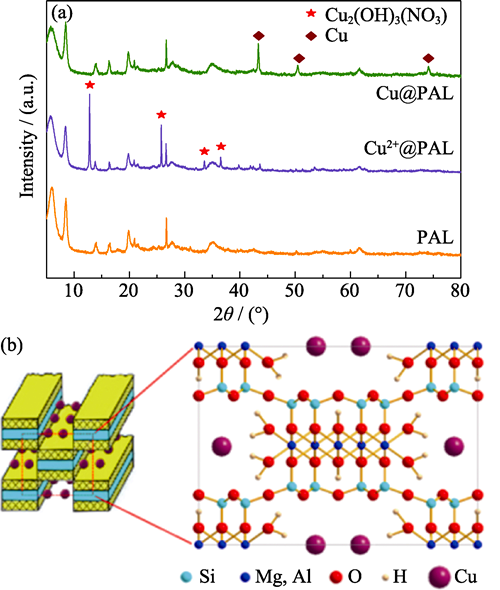
|
|
|
Mechanism of the Magnetic and Specific-heat Anomalies in Rare-earth Dodecaborides RB12 (R=Tb-Tm): an Effect of Crystal-field-splitting Order Parameter
HU Jingsan, GU Jianfei, ZHANG Weiyi
2021 Vol. 36 (8): 865–870
 Abstract
Abstract(
316 )
 HTML
HTML(
7)
 PDF
PDF(415KB)(
495
)
Rare-earth dodecaborides RB12 (R=Tb, Dy, Ho, Er, Tm) are all characterized by a controversial and unresolved magnetic and specific-heat anomaly at low temperature (TC≈3-22 K) except LuB12 with closed f-shell. Although the bump feature in magnetic susceptibilities resembles that of antiferromagnetically ordered R3+ ions, no definite magnetic structure was identified by either neutron scattering or Mössbauer spectra. The anomalies in susceptibilities, entropy, and low temperature neutron diffraction pattern all pointed to the amplitude-modulated nature of complex magnetic structure. In view of the rather small crystal-field-splitting energies of the order of meV, we propose to treat crystal-field-splitting (CFS) energy as an order parameter rather than a quantum mechanical quantity. In this way, we found that not only the magnetic and specific-heat anomalies can be explained properly by a gradual quenching of R orbital moments, but also the low temperature satellite peaks of neutron scattering spectra can be understood in terms of the spontaneously (111) dimerised structure and inelastically absorbed rattling phonon modes.

|
|
|
Application of Improved Grey Model in Photocatalytic Data Prediction
WANG Luping, LU Zhanhui, WEI Xin, FANG Ming, WANG Xiangke
2021 Vol. 36 (8): 871–876
 Abstract
Abstract(
307 )
 HTML
HTML(
7)
 PDF
PDF(477KB)(
625
)
Discrete and small samples data are usually obtained from the studies on photocatalytic removal of pollutants in water. The first-order kinetic model used to simulate and analyze the experimental data sometimes has poor fitting effect and cannot be used for data prediction. In this study, based on the discrete grey model (DGM(1, 1)), the nonlinear dynamic discrete gray model (EDGM(1, 1, α)) are established by considering the nonlinear characteristics of the data and equal dimensional information substitution method. The model is used to predict the experimental data of photocatalytic degradation of tetracycline by Bi/BiOCl/Au. As compared with DGM(1, 1) and other three models, the EDGM(1, 1, α) model has a better prediction level for the experimental data of photocatalysis. The results are in good agreement with the experimental results. This model can be used to guide the next step of experiments, which is expected to reduce the number of experiments and realize the rapid development of experimental research with low cost and energy consumption.
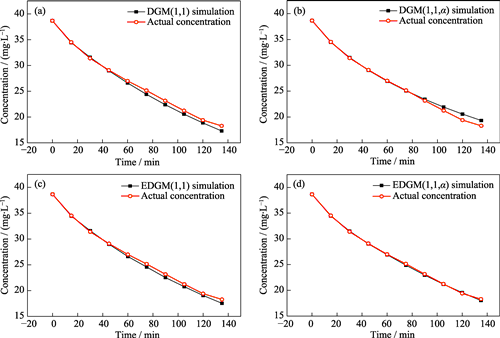
|
|
|
Fabrication of Highly Transparent Co:MgAl2O4 Ceramic Saturable Absorber for Passive Q-switching in 1.5 μm
JING Yanqiu, LIU Qiang, SU Sha, LI Xiaoying, LIU Ziyu, WANG Jingya, LI Jiang
2021 Vol. 36 (8): 877–882
 Abstract
Abstract(
409 )
 HTML
HTML(
11)
 PDF
PDF(8925KB)(
746
)
The cobalt doped magnesium aluminum spinel is an efficient material for the passive Q-switching solid state lasers operating at the near infrared region. In order to prepare Co:MgAl2O4 transparent ceramics with high absorption cross section and high in-line transmittance, the cobalt doped magnesium aluminum spinel nanopowders with pure phase were synthesized via the co-precipitation method. And after vacuum sintering and hot isostatic pressing (HIP), highly transparent 0.05at% Co:MgAl2O4 ceramics were obtained. The influences of pre-sintering temperature on morphology and optical property of the Co:MgAl2O4 ceramics were studied. With the pre-sintering temperature increasing from 1500-1650 ℃, the relative density increased from 95.2% to 98.5%, while the relative density decreased to 97.7% with the pre-sintering temperature increasing to 1700 ℃. Because of the relative low density, the Co:MgAl2O4 ceramics were all opaque after vacuum pre-sintering. In the sintering temperature range of 1500-1700 ℃, the average grain size increased from 2.3 to 11.3 μm. After HIP post-treatment, the Co:MgAl2O4 ceramics pre-sintered from 1550 to 1700 ℃ were all transparent, the Co:MgAl2O4 ceramics pre-sintered at 1650 ℃ for 5 h and HIP post-treated at 1800 ℃ for 3 h showed the best optical quality, which were 81.4% at 400 nm and 85.9% at 900 nm, and the average grain size was 16.8 μm. The broad absorption bands in the wavelength range of 500-700 nm and 1200-1600 nm indicated that Co 2+ had incorporated into the spinel lattice. Moreover, the ground state absorption cross section of the best specimen is calculated with a value of 6.18×10-19 cm2 at 1540 nm, meaning that it’s a promising candidate for passive Q-switching in solid-state lasers.
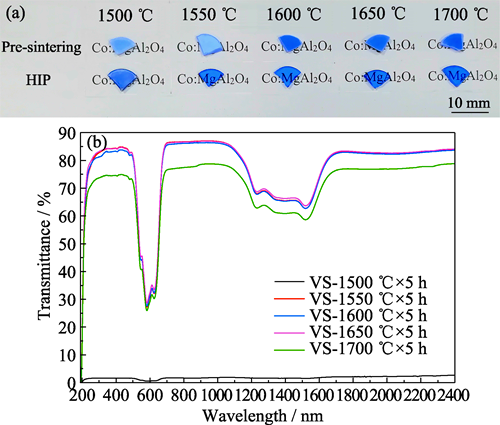
|
|
|
Ce:YAG Transparent Ceramics Enabling High Luminous Efficacy for High-power LEDs/LDs
DU Aochen, DU Qiyuan, LIU Xin, YANG Yimin, XIA Chenyang, ZOU Jun, LI Jiang
2021 Vol. 36 (8): 883–892
 Abstract
Abstract(
625 )
 HTML
HTML(
26)
 PDF
PDF(10177KB)(
974
)
Ce:YAG transparent ceramics could be combined with blue LEDs/LDs, for applications of high power white LEDs/LDs. In this study, it is found that by adjusting the thickness of Ce:YAG transparent ceramics and the doping concentration of Ce3+, the emission spectra and color coordinates of the assembled devices can be adjusted from the cold white region to the warm white region. (CexY1-x)3Al5O12 (x=0.0005, 0.0010, 0.0030, 0.0050, 0.0070 and 0.0100) transparent ceramics was fabricated by a solid state reaction method, with the high pure (≥99.99%) commercial powdersα-Al2O3, Y2O3 and CeO2 using as raw materials. The ceramic green bodies were sintered in 1750 ℃ for 20 h under vacuum of 5.0×10-5 Pa, and the ceramics were annealed at 1450 ℃ for 10 h in the muffle furnace. The in-line transmittance of double polished Ce:YAG ceramics is higher than 79% at 800 nm (0.2, 0.4, 1.0 mm in thickness, respectively). The thermal conductivity of Ce:YAG transparent ceramics decreases with the increase of measuring temperature and doping concentration. Thermal distribution of ceramics and LEDs with different thicknesses was simulated by the finite element method, and the thermal distributions of three packaging modes were compared. White light with chromaticity coordinates of (0.3319, 0.3827) and (0.3298, 0.3272) and luminous efficiency of 122.4 and 201.5 lm/W were prepared by combining transparent ceramics with LEDs/LDs. We combined Ce:YAG transparent ceramics and blue LEDs chips to produce 10 and 50 W mature lamps, which can be used for commercial purposes. Therefore, the Ce:YAG transparent ceramics is a highly promising color conversion material for high power lighting and displaying applications in the future.
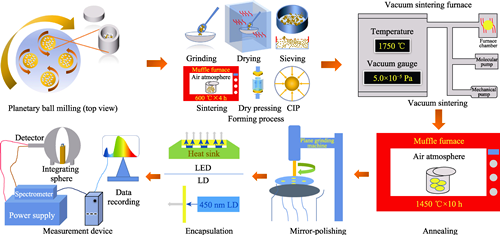
|
|
|
Ultra-large Specific Surface Area Activated Carbon Synthesized from Rice Husk with High Adsorption Capacity for Methylene Blue
ZHOU Fan, BI Hui, HUANG Fuqiang
2021 Vol. 36 (8): 893–903
 Abstract
Abstract(
725 )
 HTML
HTML(
41)
 PDF
PDF(1595KB)(
1045
)
Activated carbon with high surface area and abundant pore structure is widely used for contaminant adsorption in wastewater treatment. Rice husks (RHs) with unique composition and microstructure are often used as carbon source to prepare activated carbon. Herein, ultra-large specific surface area activated carbon was synthesized from rice husks with pre-activation and activation by supersaturated KOH solution at different temperatures. With the increase of activation temperature, the specific surface area and total pore volume of activated carbon gradually increase. The activated carbon obtained at 900 ℃ shows the largest specific surface area of 3600 m2/g and the maximal total pore volume of 3.164 cm3/g, which are significantly superior to those of the commercial activated carbon (YP-80, the specific surface area of 1310 m2/g and the total pore volume of 0.816 cm3/g, respectively). The highest maximum adsorption capacity for methylene blue was found for the activated carbon with the largest specific surface area, namely, 983 mg/g, which is almost twice as high as that of YP-80 (525 mg/g). By adsorption kinetics fitting, the results are consistent with pseudo-second-order model which indicates that the process of adsorbing methylene blue is chemical adsorption.

|
|